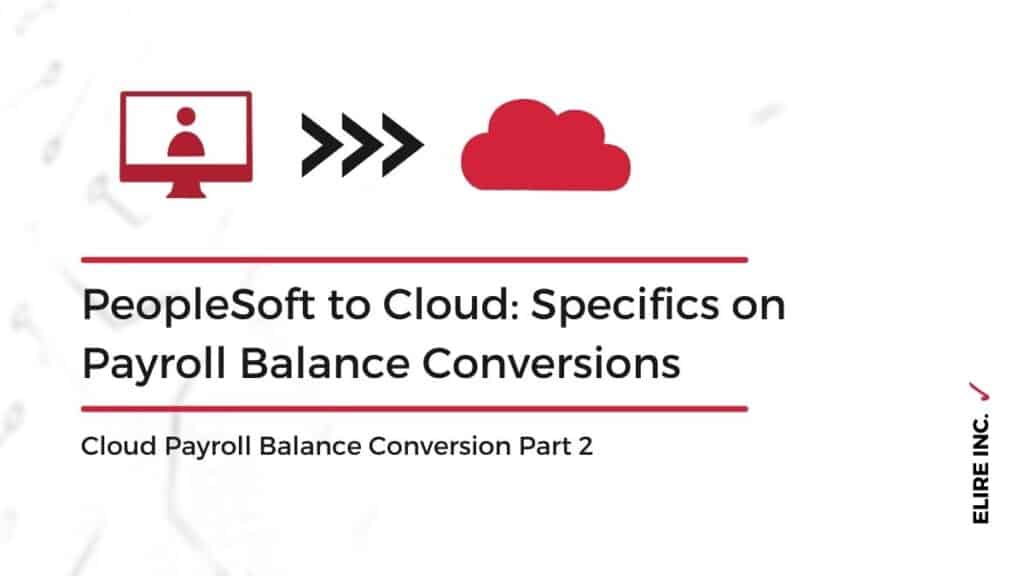
Cloud Payroll Balance Conversion Part 2
When it comes to any large projects such as moving from PeopleSoft to Oracle Cloud, there are a lot of moving pieces. Key project leaders and decision makers are faced with critical decisions, none of which have more of an impact than the decision as to when your move to Cloud will go live.
The date you select to “cut over” or go live after your new system migration is critical. Timing cutover correctly will result in less time, expense, and hassle for your organization and/or implementation team. There are many elements that might influence the go live date your team and implementation partner choose such as resource availability and timing of other projects, but if at all possible, we recommend scheduling your migration go live for the beginning of the year.
If this isn’t possible, you’ll likely see added complexity to your implementation project due to the need for a payroll balance conversion to take place. Scheduling go live for the beginning of a new quarter, where the Quarterly balances reset and balance conversions will be easiest is suggested. If it’s impossible to go live at the beginning of the quarter, balance conversions are still possible. Mid-quarter Oracle Cloud HCM balance conversions are much more complex due to the need for converting year-to-date (YTD) and quarter-to-date (QTD) balances.
Navigating the process of completing a balance conversion can be tricky. Below, we’ll detail the specific steps you need to take to undergo a balance conversion when moving from PeopleSoft to Oracle Cloud.
What are Some Key Considerations When Undergoing a Balance Conversion from PeopleSoft to Cloud?
From the technical side of things, there are a few things to keep in mind as you work to convert balances in your migration from PeopleSoft to Cloud. It’s important to create separated balance initialization batches for every LDG, or Legislative Data group. Note that even though the HCM Data Loader is multiheaded, any of the balance processing produced is not.
It is suggested that you create multiple batches so that the Load Initial Balances process can occur simultaneously. In the same batch, you must include all lines for each balance to be initialized for a particular person. Consider that the date you specify on the batch header record applies to all lines. That is, unless you enter an override date at the line level. The date at the line level must be on or before the date on the header.
Be aware that you are not able to initialize balances once the payroll processes have run. When it comes to initializing involuntary deduction balances, you must create the involuntary deduction card before processing the balance initialization. All employees must also have their tax card(s) and association(s) loaded before balances are loaded.
The largest aspect of undergoing a balance conversion that needs to be considered is the time it takes to load balances and then test. Testing will also require a significant amount of time and effort. It is recommended that you include generating year end files out of Cloud and compare these to the legacy system to ensure all balances were initialized properly and there were no misses. Spot-checking employees is not enough here – all employees and their balances should be confirmed with specific reports in Cloud HCM and PeopleSoft.
Validating before the Production cutover is also critical. Tricky situations such as employees paying taxes in multiple states, terminations and rehires in the same calendar year, and multiple involuntary deductions should be planned for and confirmed before the big day.
It is recommended to run a complete payroll and run a few key payroll audit reports to validate all the balance buckets including mandated limits. For example, yearly limit Employee Social Security.
What Are the Steps to Complete a Payroll Balance Conversion?
The first step is to determine which balances to Initialize. There are legislative and user-defined balances, each with different requirements. Next, map balances to Payroll Cloud – most payroll data in PeopleSoft is stored in the three balance tables – PS_TAX_BALANCE, PS_DEDUCTION_BAL, PS_EARNINGS_BAL. Extract any legacy balances and Create Batch Headers and Batch Lines using the “InitializeBalanceHeader.dat” and “InitializeBalanceBatchLine.dat” HDLs. Finally, submit and load the initial balances using the Payroll Flow Pattern “Load Initial Balances”. This will create date-effective balance entries. Once this is complete, reconcile the uploaded balances.
Though the process of completing a balance conversion is relatively straightforward, actually tackling this undertaking while also navigating all the other elements that go into migrating PeopleSoft to Oracle Cloud can be overwhelming. Partnering with a Cloud implementation team can help alleviate some of the burden that comes with this potential challenge. Trusting the experts who have been there before and successfully navigated every kind of balance conversion and migration will give you peace of mind.
Elire has successfully completed balance conversions, mid-quarter balance conversions, and many migrations from PeopleSoft to Cloud in our previous client work. Elire has many custom reports that can assist during balance conversion reconciliation as well as a custom Application Engine that can be used to accelerate the mapping and extraction and is in the process of building a balance conversion parallel tracking tool to be used to make comparisons during the testing process.
Elire’s unique set of Accelerator Tools can greatly assist with the process of moving from PeopleSoft to Cloud, and shorten your conversion timeline. No matter where you are in your journey to Oracle Cloud, Elire is here to help. Reach out to [email protected] to get in touch with our team and set up a time to discuss your organization’s needs in a brief discovery call. In the meantime, check out the first part of this balance conversion post, “Cloud Migration Highlights: Balance Conversion Considerations” here.
About the Expert:
Mr. Costakes serves as Elire’s Cloud Center of Excellence Lead, overseeing Elire’s Cloud ERP, Cloud HCM, and Cloud Transformation Practice Areas. Chris has 20+ Years of PeopleSoft and Oracle Cloud Experience, excelling in transforming organization’s IT footprint by migrating from on-premise applications to Oracle Cloud.
Author
-

Ms. Caron serves as Elire's Senior Marketing Specialist, specializing in content writing and digital media communications. Maddie works to deliver relevant industry updates and technical blog posts to educate and engage Elire's audience.
